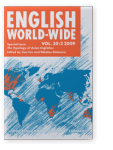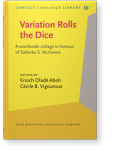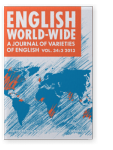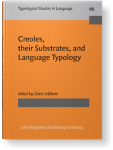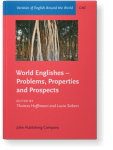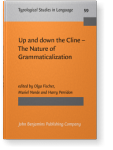Lisa Lim
List of John Benjamins publications for which Lisa Lim plays a role.
Journal
Multilingualism and Mobility in the Twenty-First Century: New Trajectories and Possibilities in Migration Linguistics
Edited by Ariane Macalinga Borlongan and Lisa Lim
Special issue of AILA Review 37:1 (2024) vi, 176 pp.
The Politics of English: South Asia, Southeast Asia and the Asia Pacific
Edited by Lionel Wee, Robbie B.H. Goh and Lisa Lim
[Studies in World Language Problems, 4] 2013. ix, 322 pp.
Subjects English linguistics | Language policy | Sociolinguistics and Dialectology
The Typology of Asian Englishes
Edited by Lisa Lim and Nikolas Gisborne
[Benjamins Current Topics, 33] 2011. vii, 120 pp.
Subjects Contact Linguistics | English linguistics | Historical linguistics | Syntax | Typology
The Typology of Asian Englishes
Edited by Lisa Lim and Nikolas Gisborne
Special issue of English World-Wide 30:2 (2009) 124 pp.
Subjects Germanic linguistics | Sociolinguistics and Dialectology
Multilingual, Globalizing Asia: Implications for policy and education. AILA Review, Volume 22
Edited by Lisa Lim and Ee-Ling Low
[AILA Review, 22] 2009. iv, 130 pp.
Subjects Applied linguistics | Language acquisition
Deconstructing Creole
Edited by Umberto Ansaldo, Stephen Matthews and Lisa Lim
[Typological Studies in Language, 73] 2007. xii, 292 pp.
Subjects Creole studies | Typology
Singapore English: A grammatical description
Edited by Lisa Lim
[Varieties of English Around the World, G33] 2004. xiv, 172 pp.
Subjects English linguistics | Germanic linguistics | Sociolinguistics and Dialectology
2024 Multilingualism and mobility in the twenty-first century: An agenda for migration linguistics Multilingualism and Mobility in the Twenty-First Century: New Trajectories and Possibilities in Migration Linguistics, Borlongan, Ariane Macalinga and Lisa Lim (eds.), pp. 1–9 | Editorial
2024 Defining migrants: Invisibilities, im/mobilities, integration Multilingualism and Mobility in the Twenty-First Century: New Trajectories and Possibilities in Migration Linguistics, Borlongan, Ariane Macalinga and Lisa Lim (eds.), pp. 10–34 | Article
In contemplating multilingualism and mobility in the 21st century, several dimensions warrant attention in the emerging field of migration linguistics. First is the move beyond migration to thinking about mobilities, in particular, the new mobilities paradigm in the social sciences which views… read more
2021 Foundings and futures: How to live like a Peranakan in the post-digital ecology Variation Rolls the Dice: A worldwide collage in honour of Salikoko S. Mufwene, Aboh, Enoch O. and Cécile B. Vigouroux (eds.), pp. 243–267 | Chapter
This chapter contemplates the positioning of the Peranakans (also known as Straits-born Chinese or Babas) – descendants of southern Chinese seafaring traders to the Malay archipelago who married local women, and settled in the region – across different eras and ecologies. We provide a critical… read more
2016 The art of losing: Beyond java, patois and postvernacular vitality – Repositioning the periphery in global Asian ecologies Endangered Languages and Languages in Danger: Issues of documentation, policy, and language rights, Filipović, Luna and Martin Pütz (eds.), pp. 283–312 | Article
This paper discusses issues in endangerment and postvernacularity in the context of Asia, a region with complex dynamics in multilingual ecologies that also includes the presence – dominance – of English, a language that entered the ecologies through colonisation. I use as illustration two minority… read more
2014 Yesterday’s founder population, today’s Englishes: The role of the Peranakans in the (continuing) evolution of Singapore English The Evolution of Englishes: The Dynamic Model and beyond, Buschfeld, Sarah, Thomas Hoffmann, Magnus Huber and Alexander Kautzsch (eds.), pp. 401–419 | Article
This paper highlights a less well known player in the contact dynamics involved in the evolution of Singapore English (SgE): the Peranakans – descendants of 18th / 19th-century southern Chinese traders in Malaya and local women, who became a prestigious minority group. As multilingual, early… read more
2013 Yamuna Kachru English World-Wide 34:3, pp. 387–389 | Article
2013 4. Kaduva of privileged power, instrument of rural empowerment? The politics of English (and Sinhala and Tamil) in Sri Lanka The Politics of English: South Asia, Southeast Asia and the Asia Pacific, Wee, Lionel, Robbie B.H. Goh and Lisa Lim (eds.), pp. 61–80 | Article
The politics of English is inseparable from the politics of other languages in multicultural, multilingual (South and Southeast) Asia; in few other places is this more painfully felt than Sri Lanka, where ethnolinguistic issues have embroiled the country in civil war for a quarter of a century. A… read more
2013 16. Conclusion The Politics of English: South Asia, Southeast Asia and the Asia Pacific, Wee, Lionel, Robbie B.H. Goh and Lisa Lim (eds.), pp. 303–316 | Article
2011 Revisiting English prosody: (Some) New Englishes as tone languages? The Typology of Asian Englishes, Lim, Lisa and Nikolas Gisborne (eds.), pp. 97–118 | Chapter
2011 Tone in Singlish: Substrate features from Sinitic and Malay Creoles, their Substrates, and Language Typology, Lefebvre, Claire (ed.), pp. 271–287 | Article
This paper focuses on aspects of tone in Singlish, the (mesolectal/basilectal) variety of English spoken in Singapore, which take up the claim of tone being a marked feature in contact varieties. While the source of tonal properties may well be the dominant Sinitic substrates, the actual… read more
2011 The typology of Asian Englishes: Setting the agenda The Typology of Asian Englishes, Lim, Lisa and Nikolas Gisborne (eds.), pp. 1–10 | Chapter
2009 Revisiting English prosody: (Some) New Englishes as tone languages? The Typology of Asian Englishes, Lim, Lisa and Nikolas Gisborne (eds.), pp. 218–239 | Article
Many New Englishes are spoken in what can often be considered multilingual contexts in which typologically diverse languages come into contact. In several Asian contexts, one typological feature that is prominent in the multilingual contact situation (the “ecology”) is tone. Given that tone is… read more
2009 Not just an “Outer Circle”, “Asian” English: Singapore English and the significance of ecology World Englishes – Problems, Properties and Prospects: Selected papers from the 13th IAWE conference, Hoffmann, Thomas and Lucia Siebers (eds.), pp. 179–206 | Article
Englishes like Singapore English (SingE) are oft-used examples of “Outer Circle” or “Asian” Englishes – categories intended as sociohistorical or regional groupings, but which cannot suggest shared linguistic properties. To discuss structural similarities or differences between Englishes in an… read more
2009 Beyond fear and loathing in SG: The real mother tongues and language policies in multilingual Singapore Multilingual, Globalizing Asia: Implications for policy and education, Lim, Lisa and Ee-Ling Low (eds.), pp. 52–71 | Article
This paper considers the real mother tongues of Singapore, namely the Chinese ‘dialects’ and Singlish, the linguistic varieties which, respectively, arrived with the original immigrants to the rapidly developing British colony, and evolved in the dynamic multilingual ecology over the decades.… read more
2009 Introduction Multilingual, Globalizing Asia: Implications for policy and education, Lim, Lisa and Ee-Ling Low (eds.), pp. 1–4 | Article
2009 The typology of Asian Englishes: Setting the agenda The Typology of Asian Englishes, Lim, Lisa and Nikolas Gisborne (eds.), pp. 123–132 | Article
2007 The sociolinguistic history of the Peranakans: What it tells us about 'creolization' Deconstructing Creole, Ansaldo, Umberto, Stephen Matthews and Lisa Lim (eds.), pp. 203–226 | Article
2004 Phonetic absence as syntactic prominence: Grammaticalization in isolating tonal languages Up and down the Cline – The Nature of Grammaticalization, Fischer, Olga, Muriel Norde and Harry Perridon (eds.), pp. 345–362 | Article
2004 2. Souding Singaporean Singapore English: A grammatical description, Lim, Lisa (ed.), pp. 19–56 | Chapter
2004 Review of Deterding, Ling & Brown (2003): English in Singapore: Research on Grammar English World-Wide 25:1, pp. 143–148 | Review
2004 1. English in Singapore and Singapore English: Background and methodology Singapore English: A grammatical description, Lim, Lisa (ed.), pp. 1–18 | Chapter




